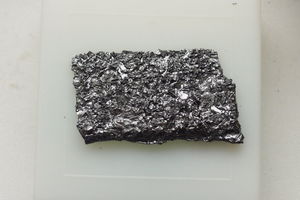Silicon carbide
 Silicon carbide sample.
| |
| Names | |
|---|---|
| IUPAC name
Silicon carbide
| |
| Other names
Carborundum
Moissanite | |
| Identifiers | |
| Jmol-3D images | Image |
| |
| Properties | |
| SiC | |
| Molar mass | 40.10 g/mol |
| Appearance | Black lustrous solid |
| Density | 3.21 g/cm3 |
| Melting point | 2,730 [convert: invalid number] |
| Boiling point | [convert: invalid number] |
| Insoluble | |
| Hazards | |
| Safety data sheet | ScienceLab |
| Except where otherwise noted, data are given for materials in their standard state (at 25 °C [77 °F], 100 kPa). | |
| Infobox references | |
Silicon carbide, also known as carborundum is a compound of silicon and carbon with chemical formula SiC, mainly used as an abrasive. Silicon carbide occurs naturally as the rare mineral moissanite.
Contents
Properties
Chemical
Physical
Availability
In Alibaba - from chinese producers.
Preparation
Because of the rarity of natural moissanite, most silicon carbide is synthetic. It is used as an abrasive, and more recently as a semiconductor and diamond simulant of gem quality. The simplest manufacturing process is to combine silica sand and carbon in an Acheson graphite electric resistance furnace at a high temperature, between 1,600 °C (2,910 °F) and 2,500 °C (4,530 °F). Fine SiO2 particles in plant material (e.g. rice husks) can be converted to SiC by heating in the excess carbon from the organic material.[15] The silica fume, which is a byproduct of producing silicon metal and ferrosilicon alloys, also can be converted to SiC by heating with graphite at 1,500 °C (2,730 °F).
Projects
- Crucible
Handling
Safety
Silicon carbide is non-flammable and non-explosive.
Effects of Exposure: To the best of our knowledge the chemical, physical and toxicological properties of silicon carbide have not been thoroughly investigated and reported. Silicon carbide is a nuisance dust capable of producing nonprogressive pulmonary fibrosis. Silicon carbide implants have caused tumors in laboratory animals.
Acute Effects: Inhalation: May cause irritation. Ingestion: No acute health effects recorded. Skin: May cause abrasive irritation. Eye: May cause abrasive irritation.
Chronic Effects: Inhalation: May cause pneumoconiosis. No other chronic health effects recorded.
Target Organs: No target organs recorded. Medical Conditions Generally Aggravated by
Exposure: Pre-existing respiratory disorders.
Carcinogenicity: NTP: No IARC: No OSHA: No
Storage
Disposal
References
Relevant Sciencemadness threads
- Chemical pages without CAS Registry Number
- Articles without EBI source
- Chemical pages without ChemSpiderID
- Chemical pages without DrugBank identifier
- Articles without KEGG source
- Articles without InChI source
- Articles without UNII source
- Convert invalid options
- Articles containing unverified chemical infoboxes
- Chemical compounds
- Inorganic compounds
- Silicon compounds
- Carbides
- Insoluble compounds